
The Allegheny River is a 325-mile (523 km) long headwater stream of the Ohio River in western Pennsylvania and New York, United States. The Allegheny River runs from its headwaters just below the middle of Pennsylvania's northern border northwesterly into New York then in a zigzag southwesterly across the border and through Western Pennsylvania to join the Monongahela River at the Forks of the Ohio on the "Point" of Point State Park in Downtown Pittsburgh, Pennsylvania. The Allegheny River is, by volume, the main headstream of both the Ohio and Mississippi Rivers. Historically, the Allegheny was considered to be the upper Ohio River by both Native Americans and European settlers.
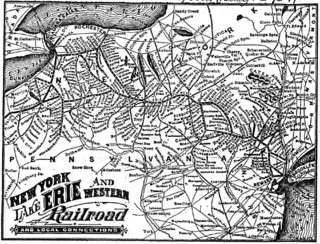
The Erie Railroad was a railroad that operated in the northeastern United States, originally connecting New York City — more specifically Jersey City, New Jersey, where Erie's former terminal, long demolished, used to stand — with Lake Erie. It expanded west to Chicago with its 1941 merger with the former Atlantic and Great Western Railroad, also known as the New York, Pennsylvania and Ohio Railroad. Its mainline route proved influential in the development and economic growth of the Southern Tier, including cities such as Binghamton, Elmira, and Hornell. The Erie Railroad repair shops were located in Hornell, and were Hornell's largest employer. Hornell was also where Erie's main line split into two routes, one north to Buffalo and the other west to Cleveland.
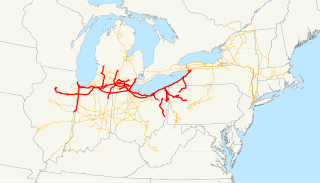
The Lake Shore and Michigan Southern Railway, established in 1833 and sometimes referred to as the Lake Shore, was a major part of the New York Central Railroad's Water Level Route from Buffalo, New York, to Chicago, Illinois, primarily along the south shore of Lake Erie and across northern Indiana. The line's trackage is still used as a major rail transportation corridor and hosts Amtrak passenger trains, with the ownership in 1998 split at Cleveland between CSX to the east, and Norfolk Southern in the west.
The Genesee Valley Canal Railroad was a part of the Pennsylvania Railroad system in western New York. It was built on the former Genesee Valley Canal alignment.

The Buffalo and Pittsburgh Railroad is a Class II railroad operating in New York and Pennsylvania.
The Jersey Shore, Pine Creek and Buffalo Railway was a railroad built in the early 1880s to give the New York Central and Hudson River Railroad access to the coal regions around Clearfield, Pennsylvania, United States. It was originally planned as part of a connecting line between the East Coast of the United States and Buffalo, New York.
The New Castle Branch was a rail line owned and operated by the Pennsylvania Railroad in the U.S. state of Pennsylvania. The line ran from New Castle north to Stoneboro, and is now entirely abandoned. At its south end, the line intersected the Erie and Pittsburgh Branch and Mahoningtown Branch. When the New Castle Branch ended at Stoneboro, the PRR had trackage rights east along the New York Central Railroad's Stoneboro Branch to Oil City and the Allegheny Branch, Chautauqua Branch, and Salamanca Branch.

The Allegheny Valley Railroad is a class III railroad that operates in Western Pennsylvania, and is owned by Carload Express, Inc.
The Nypano Railroad, earlier the New York, Pennsylvania and Ohio Railroad, was organized from the bankrupt Atlantic and Great Western Railroad in March 1880.

The Western New York and Pennsylvania Railroad is a short-line railroad that operates freight trains in Western New York and Northwest Pennsylvania, United States. The company is controlled by the Livonia, Avon and Lakeville Railroad, with which it does not connect. It started operations in 2001 on the Southern Tier Extension, a former Erie Railroad line between Hornell and Corry, owned by the public Chautauqua, Cattaraugus, Allegany and Steuben Southern Tier Extension Railroad Authority (STERA). Through acquisitions and leases, the line was extended from Corry to Meadville in 2002 and to Oil City in 2006, and in 2007 the WNY&P leased and sub-leased portions of the north-south Buffalo Line, a former Pennsylvania Railroad line mostly built by a predecessor of the defunct Western New York and Pennsylvania Railway. The two lines cross at Olean.
The Springville and Sardinia Railroad was an 11.57 mile 3 ft narrow gauge railroad organized by Springville, New York interests on May 6, 1878 from Sardinia Junction with the Pennsylvania Railroad through Sardinia to Springville. It proved to be unprofitable once the Buffalo, Rochester, and Pittsburgh Railway was completed in 1883 and the tracks were pulled up in 1886.

The Oil Creek and Allegheny River Railway was a railroad in western Pennsylvania.
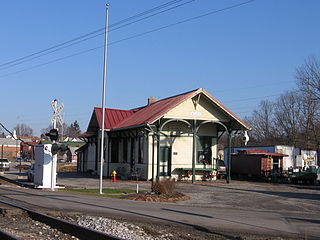
The Pittsburgh and Western Railroad was a nineteenth-century, 3 ft narrow gauge railroad connecting Pittsburgh with coal supplies and the oil field around Titusville, Pennsylvania. Its right-of way formed the main line of the Baltimore and Ohio Railroad west from Pittsburgh. It was reorganized in 1889 under Malcolm A. McDonald.
The Little Saw Mill Run Railroad was a 4 ft 8 1⁄2 instandard gauge coal railroad in Allegheny County, Pennsylvania. It was incorporated July 23, 1850, and opened in April 1853. Originally, it was owned by the Harmony Society, and ran from Temperanceville, Pennsylvania on the Ohio River to Banksville, Pennsylvania, running parallel to Saw Mill Run and Little Saw Mill Run. In an agreement with the 3 ft narrow gauge Pittsburgh Southern Railroad, it ran dual gauge tracks. It became part of the railroad empire of George J. Gould, merging with the West Side Belt Railroad in 1897.
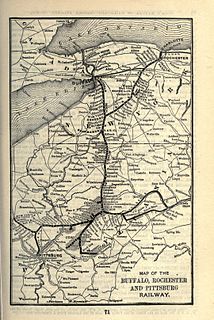
The Buffalo, Rochester and Pittsburgh Railway was one of the more than ten thousand railroad companies founded in North America. It lasted much longer than most, serving communities from the shore of Lake Ontario to the center of western Pennsylvania.

The Coudersport and Port Allegany Railroad was a short line railroad that operated in Potter and McKean Counties in Pennsylvania in the United States between 1882 and 1964. The original line ran 17 miles (27 km) along the Allegheny River between the boroughs of Coudersport, the county seat of Potter County, and Port Allegany in McKean County. The line was originally a 3 ft narrow gauge and converted to 4 ft 8 1⁄2 instandard gauge in 1889. It was prosperous during a lumber boom in the region and expanded east to Ulysses. The lumber boom ended in the early 20th century and the line slowly declined until 1964, when it was purchased by the Wellsville, Addison and Galeton Railroad. The line was finally abandoned in 1970. Today the only surviving building from the railroad is the Coudersport and Port Allegany Railroad Station, which was listed on the National Register of Historic Places in 1976 and serves as the town hall for Coudersport today. As of 2009, much of the C&PA railroad grading can still be found. Railroad bridge abutments exist at Lillibridge Creek in Port Allegany and along the Allegheny River at Coleman Mills, east of Roulette, and east and west of Coudersport.
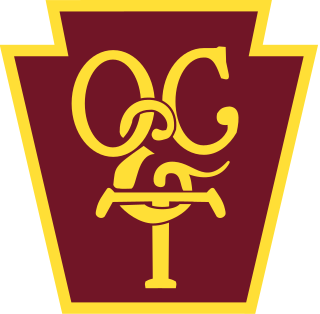
The Oil Creek and Titusville Railroad is a tourist railroad that runs from Titusville to Rynd Farm north of Oil City in the U.S. state of Pennsylvania. The Oil Creek and Titusville Lines is the designated operator of the railroad, as well as the freight carrier on the line.
The Maryland Central Railroad (MCRR) was a 19th-century 3 ft narrow gauge railroad in Maryland, with a small track section in Pennsylvania. It operated freight and passenger trains between Baltimore and Delta, Pennsylvania.
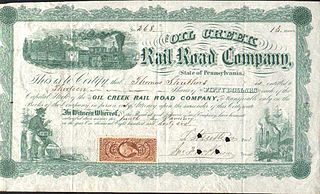
The Oil Creek Rail Road Company (OCRR) was a railroad in western Pennsylvania.













